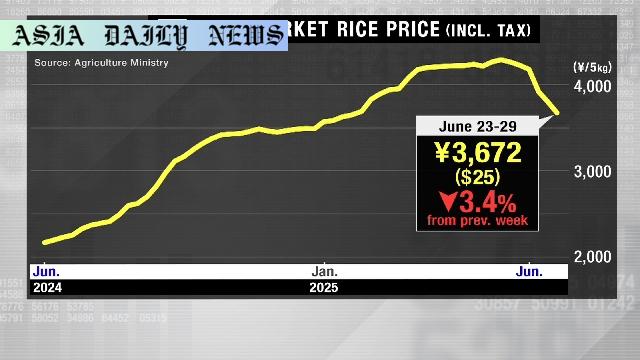Rice prices drop to 5-month low due to cheaper grain sales from government stockpiles in Japan’s supermarkets.
Key Point 1: Rice prices in Japanese supermarkets have fallen to a five-month low.
Key Point 2: Prices declined by 3% in one week but remain 63% higher than last year.
Key Point 3: The drop is attributed to an increase in cheaper grains from government reserves.
Key Point 4: The agriculture ministry conducted a nationwide survey to gather the statistics.

Recent Decline in Japan’s Supermarket Rice Prices
In a noteworthy development for Japan’s household economy, rice prices in supermarkets have plummeted to a five-month low, marking the sixth consecutive week of decline. This drop has been driven by the increased availability of less expensive grain sourced from government stockpiles, aimed at easing the financial burden on domestic consumers amid rising global food inflation. Despite this relief, prices still remain significantly higher when compared to the same period last year.
The Japanese Ministry of Agriculture, Forestry, and Fisheries conducted a survey covering roughly 1,000 supermarkets nationwide during the week ending June 29. The results highlight a 3% week-on-week decline in the price of a standard 5-kilogram rice bag, now retailing at 3,672 yen, approximately 25 USD including tax. Blended rice, among other varieties sourced from government stockpiles, saw a 4% decrease in price within the same timeframe. Although the trend is positive for consumers, the current price levels are still 63% higher than a year ago, underscoring ongoing economic challenges.
Impact on Consumers Amid Economic Stress
The surge in rice prices throughout the past year has posed financial challenges for households across Japan. The increased availability of government reserve grains at reduced costs provides a reprieve for those grappling with higher living expenses. For many, rice is a staple component of daily meals, making its affordability critical amid global commodity price volatility that, in part, stems from supply chain constraints and geopolitical factors. Farmers, on the other hand, may face increased pressure as market prices dip, raising questions about sustainable incomes in the agricultural sector.
Government’s Economic Policies at Play
The government’s active intervention in releasing stockpiled grain to curb price inflation is a critical policy move that underscores its commitment to economic stability. By facilitating better access to affordable food options, policymakers demonstrate a practical approach to battling domestic inflation amid global economic turbulence. This also reflects a balancing act between addressing consumer interests and supporting farmers, where striking harmony between these two activities remains an ongoing challenge. Going forward, monitoring price trends and implementing well-calibrated policy interventions will be vital to sustaining both consumer welfare and agricultural livelihoods.
As global inflation continues to exert pressure on economies around the world, Japan’s ability to manage such price declines in essential commodities could serve as a case study for balancing economic policies, consumer needs, and supply chain realities. For now, the hope remains that cumulative efforts of the government and agricultural players will ensure long-term affordability and sustainability in Japan’s food markets.
Commentary
A Timely Relief for Japanese Households
The drop in Japan’s rice prices is undeniably a welcome relief for the country’s households, especially given the economic strain caused by rising commodity costs. For many families, rice is not just a staple food but also a dietary constant, making its price a significant indicator of overall affordability for daily living. The government’s move to release cheaper grains from stockpiles highlights a pertinent strategy to ensure food remains accessible during trying times.
The Bigger Economic Picture and Challenges
However, while the price decline is good news for consumers, deeper challenges lie ahead. The fact that rice prices are still 63% higher than last year underscores inflationary pressures that haven’t fully abated. In this light, Japan’s agricultural policies face a delicate juggling act—on the one hand, efforts to provide cheaper food must continue, while on the other hand, the needs of domestic farmers, who may suffer losses when prices drop, also need attention. This complexity is emblematic of broader economic challenges tied to affordability versus sustainability.
Future Considerations for Policy and Industry
Moving forward, it will be crucial for Japan’s policymakers to take a long-term view. Beyond temporary price stabilization, investments in agricultural innovation, supply chain resilience, and alternative income streams for farmers will play an essential role. Similarly, possibilities of localized food production diversification could mitigate future risk factors. It is equally vital to communicate these changes with transparency, ensuring public understanding and support. While this recent decline in rice prices provides short-term comfort, sustainable solutions will require commitment and effort at every level of society.


